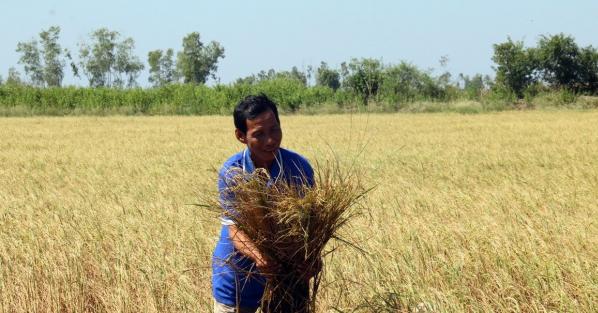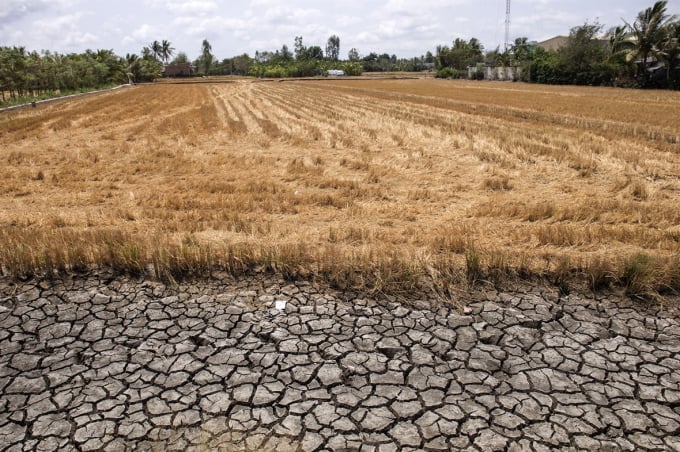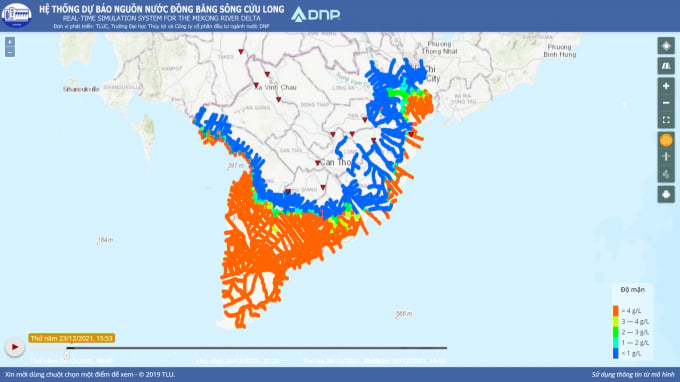November 20, 2025 | 15:23 GMT +7
November 20, 2025 | 15:23 GMT +7
Hotline: 0913.378.918
November 20, 2025 | 15:23 GMT +7
Hotline: 0913.378.918

The Mekong Delta region frequently suffers from extreme weather events, one of which is saltwater intrusions.
In the past 20 years, the reality shows that the Mekong Delta region regularly suffers from many extreme weather phenomena, one of which is saltwater intrusion. However, the cause of that situation is not only due to the hydropower dams upstream of the Mekong River.
In the new study "Saltwater intrusion in 2020 is the worst in the last century in the Mekong Delta: Impacts, causes and management suggestions", Dr. Doan Van Binh (Irrigation University, Kyoto University), Dr. Ho Huu Loc (Asian Institute of Technology) and international colleagues focused on understanding the saltwater intrusion occurring in the Mekong Delta during the 2019–2020 dry season.
Based on irrigation data from the Southern Institute of Irrigation, researchers found that in the 2019–2020 dry season, the Mekong Delta had to experience an extremely severe drought, even surpassing 2015-2016 years.
Saltwater intrudes up to 110 kilometers inland, about 10 kilometers deeper than the historical average, and in many locations surpasses the 2015–2016 peak at the same time. For example, the saltwater intrusion level in Ham Luong river in February 1019 was 71 kilometers, surpassing the corresponding record of 2016 of 11 kilometers.
One more feature of the 2019–2020 dry season, the saltwater intrusion was detected in November 2019, 2.5 to 3.5 months earlier than the annual average (10–20 days earlier than in 2015– 2016) and again lasted for about 30 days. As of early February 2020, nearly 40,000 households lacked fresh water, mainly in coastal provinces.
In this study, scientists found that the main causes leading to the severity of saline intrusion in the Mekong Delta are the upstream hydropower dams; land subsidence; corresponding sea-level rise; riverbed sand mining.

During the 2019–2020 dry season, the Mekong Delta experienced an extremely severe drought. Photo: Thong Hai.
The researchers also pointed out that, despite the discharge of the upstream dam, the water level in the river is still low because the river bed has been lowered. The cause of this situation is that 40% of the total alluvium and sediment on the Mekong River has been retained by upstream dams; Illegal sand mining in localities in the Mekong Delta causes canals in the river bottom...
Sand mining has increased to 56% in 2018, especially on the Tien Giang River, the section from Tan Chau to My Thuan, and the Vam Nao canal. Scientists have shown that such illegal sand mining not only directly affects but also promotes saltwater intrusion in the Mekong Delta.
Therefore, the researchers have recommended that to minimize the impact of saltwater intrusion in the dry season in the Mekong Delta, Vietnam needs to adopt some useful measures at various scales, from pursuing external efforts to the internal management of the Mekong Delta through the development of early intrusion warnings.
Also, strengthen strict management measures to limit illegal sand mining on the Mekong River, reduce pressure on groundwater resources through limiting drilling wells for freshwater, and apply other forms of sustainable farming in agriculture.
Recently, to help people in the Mekong Delta region promptly respond to and prevent drought and salinity in the context of climate change, which is forecasted with a more frequent frequency, severity, and severity in the coming time, the Water Plant Nhi Thanh (Long An province) has collaborated with the Southern University of Water Resources to develop software to forecast the level of saline intrusion in the Mekong River.
Accordingly, with just a simple operation, click on the link http://waterdata.vn/mekong/mrss or download the MRSS application (Mekong MRSS), touch any location in the Mekong Delta, immediately, detailed parameters of salinity, water level over time will be displayed in detail.

The software predicts the level of saltwater intrusion in the Mekong River MRSS.
The software is not only convenient for managers, operators, meteorological forecasting agencies but also any citizen who needs it, can quickly update on the situation of drought and salinity.
Assoc. Prof. Dr. Nghiem Tien Lam, Head of the Department of Integrated Coastal Management, Southern Water Resources University, said that to ensure accuracy, the software has collected a series of information and data about the water level; actual salinity measured from 2016 to 2020 at 20 meteorological stations and combined with actual measured data at Dong Tam Water Plant (Tien Giang Province) and Nhi Thanh Water Plant (Long An province), as a reference basis and analysis.
This software can forecast detailed water levels, salinity up to hourly in any area in the Mekong Delta over 30 days. The software is simply optimized for users through intuitive images and movements to popularize to all users, not only limited to research units or regulatory agencies but towards so that each person, each family can monitor and be proactive about the developments of drought and salinity.
The software to forecast drought and salinity is expected to be an effective tool, not only giving a forecast of an area but also a whole view of the Mekong Delta region, supporting local departments, agencies, and people soon have a plan to respond to and prevent drought and salinity in daily life and production.
Vice-Chairman of the Vietnam Water Supply and Sewerage Association Tran Anh Tuan said that this is an inevitable trend in the 4.0 era, not only helping departments, local branches, and people to be proactive in responding to natural disasters. It is also a source of data, providing great support in research, forecasting, and combating climate change.
Translated by Ha Phuc

(VAN) The information was shared at the seminar 'Urban Agriculture - Solutions for Developing Green Spaces,' organized by the Kinh te & Do thi Newspaper and the Biotechnology Center of Ho Chi Minh City.
/2025/11/19/4141-2-132831_216.jpg)
(VAN) One of Japfa's outstanding solutions is implementing digital transformation and artificial intelligence (AI) to optimize operations, enhance productivity, and advance sustainable development.
/2025/11/19/4847-1-093540_448.jpg)
(VAN) The Gia Lai Provincial People’s Committee had a working session with the delegation of the U.S. Department of Agriculture, the State of Idaho, and representatives of the State's leading enterprises.

(VAN) Ca Mau has a sufficient foundation to become a strong regional aquaculture center, where production integrates the economy, the environment, and the lives of the people.

(VAN) SEIKI Group envisions itself as a pioneer in the ‘dual transformation’ of digital technology and green industry, standing alongside the Government and Vietnamese businesses in their pursuit of sustainable development.

(VAN) The VNGEONET network affirms Viet Nam's progress in mastering digital space, providing a precise positioning data platform to serve socioeconomic development.
/2025/11/14/3247-1-184556_35.jpg)
(VAN) Thai Nguyen is methodically implementing digital transformation in the livestock sector, laying the foundation for a modern, transparent, and sustainable agriculture.